Physical Address
304 North Cardinal St.
Dorchester Center, MA 02124
Physical Address
304 North Cardinal St.
Dorchester Center, MA 02124
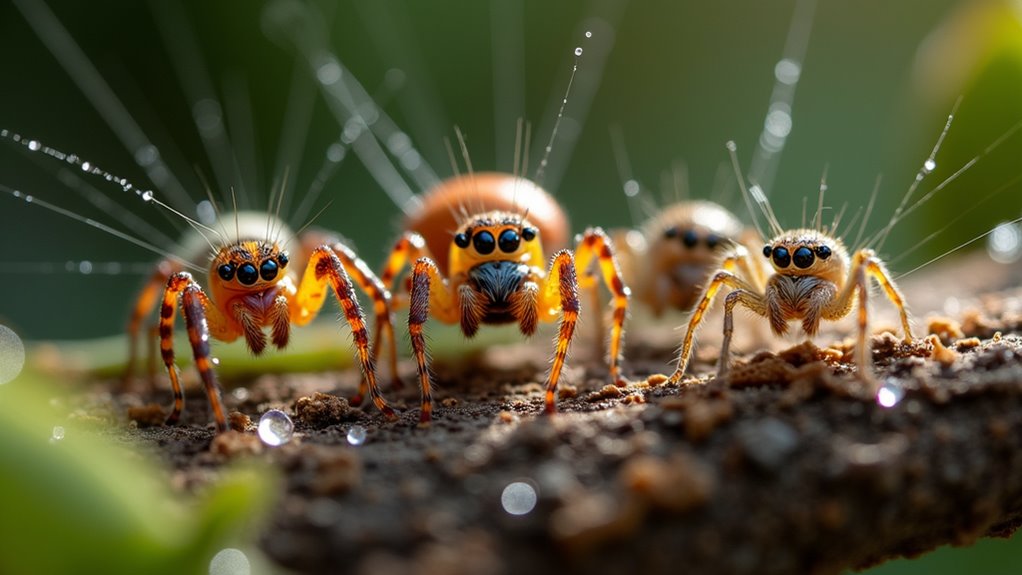
Hidden among Portugal's diverse landscapes, these 7 remarkable spider species showcase fascinating behaviors that will change how you view these misunderstood creatures.
Have you ever spotted a spider scurrying across your garden in Portugal? These fascinating creatures are more diverse than you might think. From the elegant Cross Orbweaver spinning perfect webs to the caring Nursery Web Spider carrying her egg sac, Portugal’s arachnid population is abundant with unique behaviors and adaptations. You’ll find these eight-legged architects in gardens, forests, and even your home—each playing a vital role in maintaining ecological balance. What secrets might these silent hunters be hiding in plain sight?
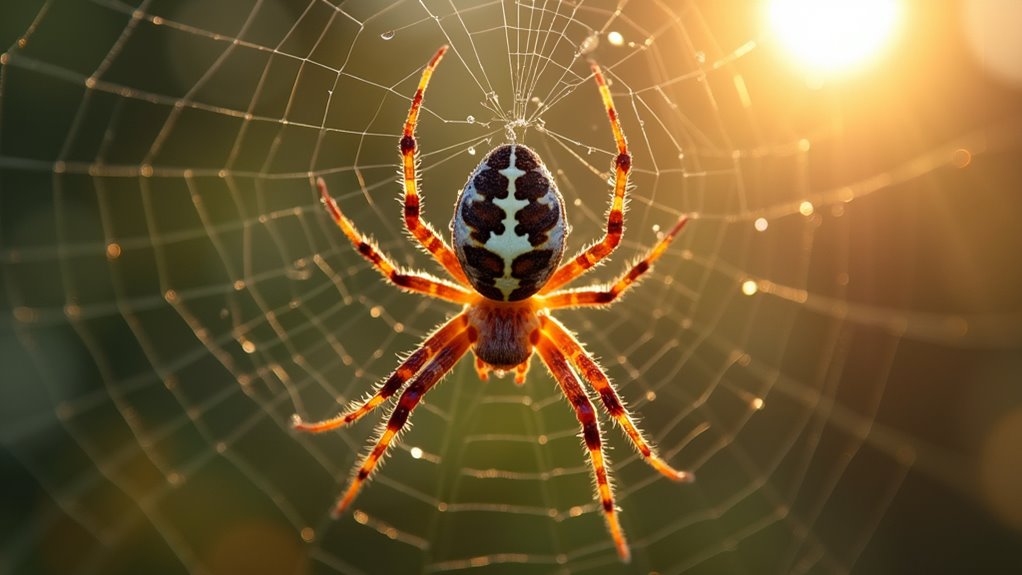
The Cross Orbweaver is one of Portugal’s most recognizable eight-legged residents, commonly decorating gardens, forests, and meadows across the country. You’ll spot these talented weavers hanging upside down at the center of their intricate orb-shaped webs, which they often rebuild daily.
These spiders range from light yellow to dark grey, but they’re always identifiable by the distinctive white cross pattern on their abdomen. Females measure between 6.5-20mm, while males are slightly smaller at 5.5-13mm.
The Cross Orbweaver’s signature white cross decorates abdomens of all colors, with females growing up to 20mm and males slightly smaller.
Also known as European Garden Spiders or Crowned Orb Weavers, they’re active both day and night, catching small flying insects in their spiral webs. Albufeira Old Town is a popular destination in Portugal where you can observe these spiders in their natural habitat.
You’ll frequently find them near buildings or lighted areas, where they provide natural pest control for your garden. The Araneus diadematus species documented in Portuguese gardens is characterized by brown spikey legs and distinctive white markings on its body.
While the Cross Orbweaver captures attention with its distinctive web-building, another fascinating arachnid showcases extraordinary parental dedication across Portugal’s varied landscapes.
The European Nursery Web Spider (Pisaura mirabilis) exhibits remarkable maternal care unlike most arachnids. You’ll recognize females by their larger size and dark epigyne marking.
During courtship, males present silk-wrapped prey as nuptial gifts and may feign death to avoid becoming a post-mating meal! Nuptial gifts are a common courtship behavior observed in these spiders.
After mating, females carry their egg sacs in their chelicerae until hatching time approaches. They’ll then construct a protective tent-like “nursery web” in vegetation where spiderlings remain under mom’s watchful guard for several days. These pale grey-brown spiders are easily identified by longitudinal dark stripes that run along their bodies.
These active hunters don’t build webs for prey capture but sprint to ambush insects during daylight hours. You’ll spot them thriving in Portugal’s grasslands, gardens, and forest edges throughout the temperate regions.
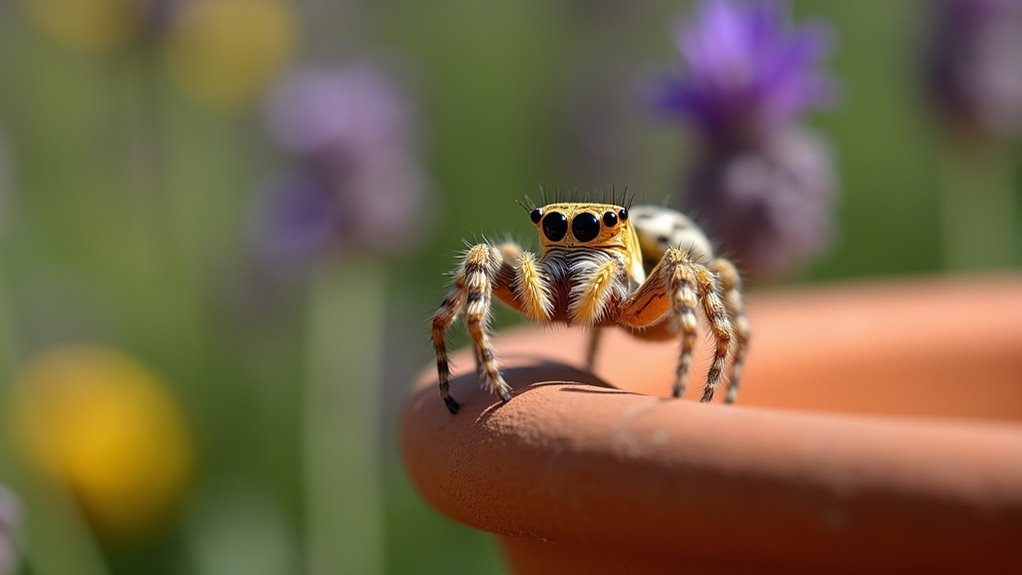
Among Portugal’s diverse arachnid inhabitants, jumping spiders represent nature’s perfect hunters, with Menemerus semilimbatus standing out as a garden favorite. You’ll recognize these small wonders by their flat bodies (6.5-8.4mm long), distinctive V-shaped markings on yellowish-gray abdomens, and their signature large, forward-facing eyes.
Unlike web-building spiders, these active hunters stalk and pounce on prey, using their incredible vision and jumping abilities. They’ve adapted beautifully to human environments, commonly patrolling walls and garden plants throughout Portugal’s Mediterranean regions. Their hairy whitish palps are another distinctive feature that helps with identification.
Their bodies, covered in dense grayish-white hairs, help them sense their surroundings. Lisbon’s rooftop hotels offer an ideal habitat for these fascinating creatures.
Portugal’s fascinating arachnid diversity includes the remarkable Humped Orbweb Spider (Gibbaranea gibbosa), easily recognized by its distinctive abdominal hump. You’ll find this common species throughout Portugal, particularly along coastal areas, thriving in woodlands, hedgerows, and evergreen vegetation below 1000m altitude.
As skilled architects, these spiders construct complex orb webs among trees and shrubs, playing a vital role in controlling local insect populations. Unlike their counterparts in other regions that prefer higher elevations, Portuguese populations adapt well to various environments. These spiders are identified by their dark brown prosoma and light brown legs with distinctive dark bands.
Adult specimens are most active during early to mid-summer, with males typically molting earlier than females. Though classified with moderate identification difficulty (rating 3), their conservation status remains “Least Concern,” despite potential threats from habitat destruction and climate change. The Azores and Madeira are two of Portugal’s beautiful island destinations that offer unique natural environments for these spiders to thrive.
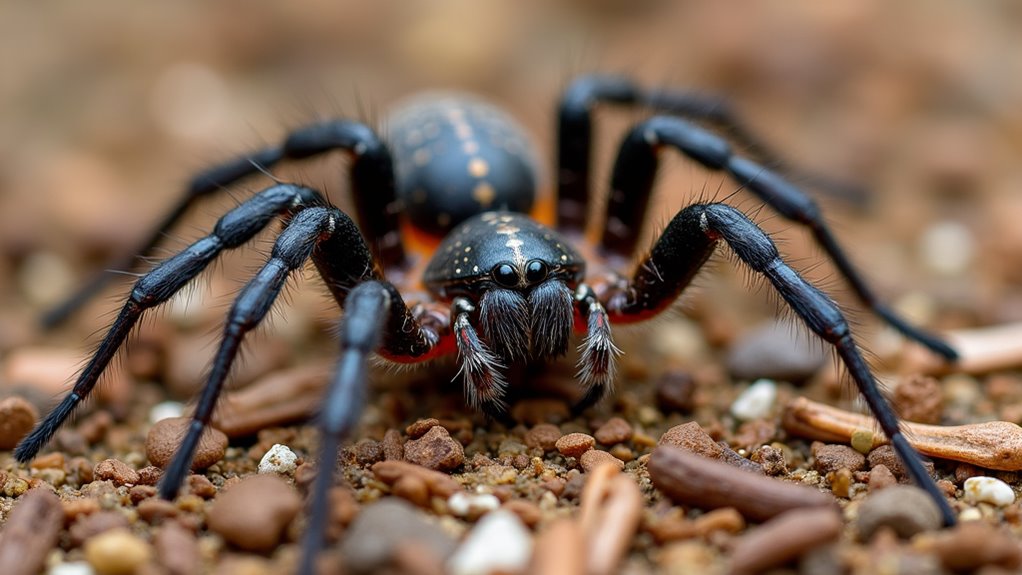
The Common Combtailed Spider (Iberina montana) offers a striking contrast to the elevated web architects of Portugal’s forests. This ground-dwelling member of the Hahniidae family thrives in damp environments, constructing sheet webs among leaf litter, moss, and pine needles.
You’ll find these fascinating spiders throughout the year, with mature females present during all seasons while males appear periodically. These tiny arachnids have a body length of only 1.4-2mm, making them easy to overlook in their natural habitat. Unlike active hunters, they rely on their intricate sheet webs for capturing prey. Sintra’s picturesque landscapes provide ideal habitats for these diminutive web weavers.
These patient web specialists remain on duty year-round, with faithful females maintaining their intricate traps while males make seasonal appearances.
While small in stature, these spiders contribute considerably to Portugal’s ecosystem as they quietly patrol the forest floor.
This running crab spider, previously known only in Algeria and Italy, was collected using modified Schoenly traps and hand-collecting methods, yielding 13 specimens in 2004 and 2 more in 2005.
The discovery represents the westernmost Mediterranean occurrence of this species. Tavira and Faro are two of the most enchanting destinations in Portugal, offering visitors a glimpse into the country’s rich history and culture.
You’ll find this ground-dwelling hunter in mixed woodland habitats, often associated with carrion-based ecosystems.
While currently documented only in central Portugal, experts believe it likely inhabits other Mediterranean regions across the country.
The finding validates Mediterranean dispersal patterns for this fascinating arachnid.
This species has been recently reclassified from Philodromus bistigma to Pulchellodromus bistigma in current arachnological literature.
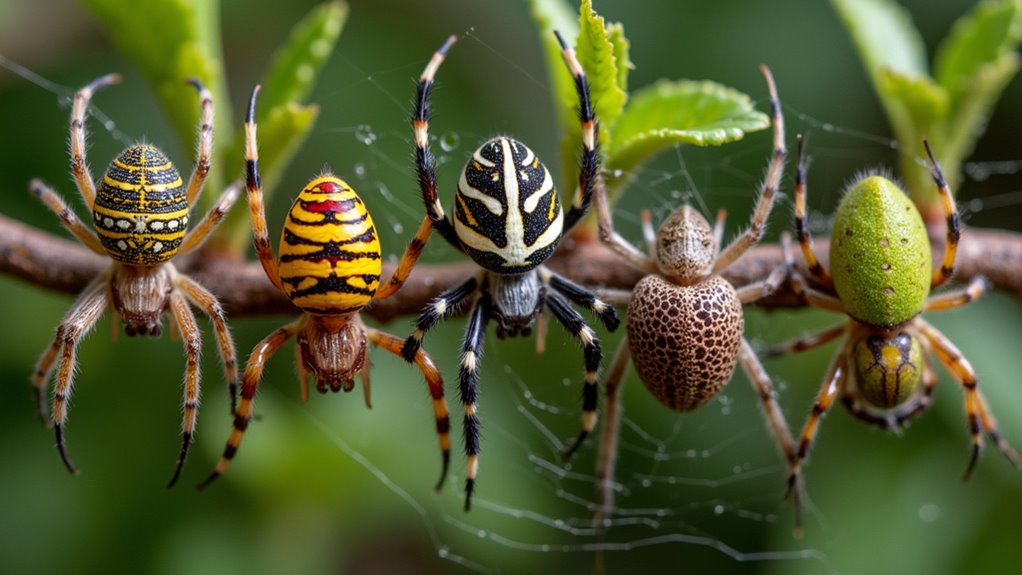
While Portugal continues to yield exciting spider discoveries like Philodromus bistigma, understanding these arachnids’ broader ecological functions reveals their true importance. You’ll find these eight-legged creatures are essential components of Portugal’s diverse ecosystems, from southern oak forests to coastal regions. Mainland Portugal hosts several endemic spider species that exist nowhere else in the world, making their conservation particularly crucial. The best breakfast spots in Faro, Portugal can provide a great start to the day before exploring the region’s natural wonders.
Portugal’s arachnid treasures aren’t just fascinating discoveries—they’re vital ecological linchpins throughout the nation’s diverse habitats.
Portugal’s endemic spiders face threats from urbanization, habitat fragmentation, and climate change. Their conservation requires protecting specialized microhabitats and ensuring connectivity between populations—efforts that benefit entire ecosystems.
You’ve now glimpsed into the secret world of Portugal’s eight-legged architects! From the meticulous Cross Orbweaver to the caring Nursery Web mother, these fascinating creatures aren’t just Halloween decorations—they’re essential ecological allies. Next time you’re wandering through a Portuguese garden or woodland, look closer at these tiny titans. They’re silently weaving their stories into the tapestry of Portugal’s biodiversity, one silken thread at a time.